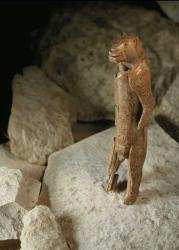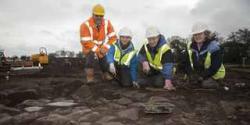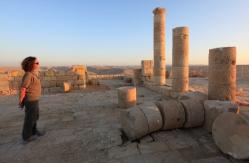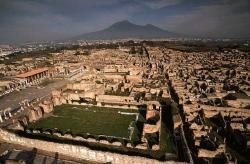INSTITUT SUPERIEUR D'ANTHROPOLOGIE
INSTITUTE OF ANTHROPOLOGY
ONLINE COURSES / COURS A DISTANCE
OPEN COURSE : FEBRUARY 2013
HRM 104 : INTRODUCTION TO INTANGIBLE CULTURAL HERITAGE
REGISTER NOW
ALLEMAGNE –  Stadel Cave - Work carved from mammoth ivory has been redated and 1,000 new fragments discovered—but it won’t make it to British Museum show. The star exhibit initially promised for the British Museum’s “Ice Age Art” show will not be coming—but for a good reason. New pieces of Ulm’s Lion Man sculpture have been discovered and it has been found to be much older than originally thought, at around 40,000 years. This makes it the world’s earliest figurative sculpture. At the London exhibition, which opens on 7 February, a replica from the Ulm Museum will instead go on display. The ivory from which the figure had been carved had broken into myriad fragments. When first reconstructed, around 200 pieces were incorporated into the 30cm-tall sculpture, with about 30% of its volume missing. The latest news is that almost 1,000 further fragments of the statue have been found, following recent excavations in the Stadel Cave by Claus-Joachim Kind. Most of these are minute, but a few are several centimetres long. Some of the larger pieces are now being reintegrated into the figure. Conservators have removed the 20th-century glue and filler from the 1989 reconstruction, and are now painstakingly reassembling the Lion Man, using computer-imaging techniques. “It is an enormous 3D puzzle”, says the British Museum curator Jill Cook.The new reconstruction will give a much better idea of the original. In particular, the back of the neck will be more accurate, the right arm will be more complete and the figure will be a few centimetres taller. Even more exciting than the discovery of new pieces, the sculpture’s age has been refined using radio-carbon dating of other bones found in the strata. This reveals a date of 40,000 years ago, while until recently it was thought to be 32,000 years old. Once reconstruction is completed, several tiny, unused fragments of the mammoth ivory are likely to be carbon dated, and this is expected to confirm the result. This revised dating pushes the Lion Man right back to the oldest sculptures, which have been found in two other caves in the Swabian Alps. These rare finds are dated at 35,000 to 40,000 years, but the Lion Man is by far the largest and most complex piece. A few carved items have been found in other regions which are slightly older, but these have simple patterns, not figuration.
Stadel Cave - Work carved from mammoth ivory has been redated and 1,000 new fragments discovered—but it won’t make it to British Museum show. The star exhibit initially promised for the British Museum’s “Ice Age Art” show will not be coming—but for a good reason. New pieces of Ulm’s Lion Man sculpture have been discovered and it has been found to be much older than originally thought, at around 40,000 years. This makes it the world’s earliest figurative sculpture. At the London exhibition, which opens on 7 February, a replica from the Ulm Museum will instead go on display. The ivory from which the figure had been carved had broken into myriad fragments. When first reconstructed, around 200 pieces were incorporated into the 30cm-tall sculpture, with about 30% of its volume missing. The latest news is that almost 1,000 further fragments of the statue have been found, following recent excavations in the Stadel Cave by Claus-Joachim Kind. Most of these are minute, but a few are several centimetres long. Some of the larger pieces are now being reintegrated into the figure. Conservators have removed the 20th-century glue and filler from the 1989 reconstruction, and are now painstakingly reassembling the Lion Man, using computer-imaging techniques. “It is an enormous 3D puzzle”, says the British Museum curator Jill Cook.The new reconstruction will give a much better idea of the original. In particular, the back of the neck will be more accurate, the right arm will be more complete and the figure will be a few centimetres taller. Even more exciting than the discovery of new pieces, the sculpture’s age has been refined using radio-carbon dating of other bones found in the strata. This reveals a date of 40,000 years ago, while until recently it was thought to be 32,000 years old. Once reconstruction is completed, several tiny, unused fragments of the mammoth ivory are likely to be carbon dated, and this is expected to confirm the result. This revised dating pushes the Lion Man right back to the oldest sculptures, which have been found in two other caves in the Swabian Alps. These rare finds are dated at 35,000 to 40,000 years, but the Lion Man is by far the largest and most complex piece. A few carved items have been found in other regions which are slightly older, but these have simple patterns, not figuration.
http://www.theartnewspaper.com/articles/Ice-Age-iLion-Mani-is-worlds-earliest-figurative-sculpture/28595
ROYAUME UNI –  Oakenholt - Contractors working on the site of a controversial housing development have uncovered an exciting Roman find dating back almost 2,000 years. The discovery of a well-preserved section of Roman road, pottery, buildings and evidence of an industrial complex processing lead and silver mined at nearby Halkyn Mountain was made on land in Oakenholt, Flint, where work has started on the first phase of the Croes Atti development. Will Walker of Ewloe-based Earthworks Archaeology, who are carrying out the investigations, said: “It’s a fabulous find and it’s on our doorstep. “We have a remarkably well-preserved Roman road in good condition and the site is throwing up all manner of interesting things, including a lot of lead which suggests it was connected with the lead workings on Halkyn Mountain. “The lead – and silver – would have been processed at this site, converted into lead ingots, known as pigs, and probably transported to Chester by barge and would have been used in the building trade for pipes and roofing.. Experts have been using metal detectors and have also uncovered high quality Samian ware pottery, made in Gaul – now southern France – and exported all over the Roman Empire. Leigh Dodds, principal archaeologist with Earthworks Archaeology, added: “A large building was excavated further down the road back in the 1970s and that may have been the home of the procurator, the Roman official in charge of this settlement. “Nothing had been found in this area but there is clear evidence of a settlement with buildings either side of the Roman road.”
Oakenholt - Contractors working on the site of a controversial housing development have uncovered an exciting Roman find dating back almost 2,000 years. The discovery of a well-preserved section of Roman road, pottery, buildings and evidence of an industrial complex processing lead and silver mined at nearby Halkyn Mountain was made on land in Oakenholt, Flint, where work has started on the first phase of the Croes Atti development. Will Walker of Ewloe-based Earthworks Archaeology, who are carrying out the investigations, said: “It’s a fabulous find and it’s on our doorstep. “We have a remarkably well-preserved Roman road in good condition and the site is throwing up all manner of interesting things, including a lot of lead which suggests it was connected with the lead workings on Halkyn Mountain. “The lead – and silver – would have been processed at this site, converted into lead ingots, known as pigs, and probably transported to Chester by barge and would have been used in the building trade for pipes and roofing.. Experts have been using metal detectors and have also uncovered high quality Samian ware pottery, made in Gaul – now southern France – and exported all over the Roman Empire. Leigh Dodds, principal archaeologist with Earthworks Archaeology, added: “A large building was excavated further down the road back in the 1970s and that may have been the home of the procurator, the Roman official in charge of this settlement. “Nothing had been found in this area but there is clear evidence of a settlement with buildings either side of the Roman road.”
http://www.flintshirechronicle.co.uk/flintshire-news/local-flintshire-news/2013/01/31/2-000-year-old-road-uncovered-at-croes-atti-development-site-in-oakenholt-flint-51352-32713315/
ISRAËL –  Avdat - Nabatean King Obodas, revered as a deity, built the southern Negev city of Avdat 2000 years ago. Vandals tried to destroy it three years ago. Now it has been restored. The Nabatean city of Avdat, named after King Obodas who was known in Arabic as Abdah, is located in Avdat National Park, which includes hiking trails, springs, groves and wildlife. The city is on the “Spice Route” along which merchants traveled with perfumes and spices from East Africa and Arabia. Historians estimate that the Nabateans were nomadic tribes from northern Arabia and who settled in the area after the first century in the Common Era, when they ere influenced by the Green Hellenistic world. The Nabatean way stations at the main crossroads in the Negev developed into cities, where the former nomads developed an agriculture based on terraces built on the hillsides. Nabatean Avdat also included a residential quarter, a military camp and various pens in which camels, sheep and goats were kept, and horses which became famous as racehorses were bred. The Romans conquered the Nabatean kingdom, and Avdat fell into decline. Nature took over and destroyed it in an earthquake in the year 363. In the sixth century, under Byzantine rule, a citadel and a monastery with two churches were built on the acropolis and residential quarters were established on the slopes. This city was destroyed, probably by another earthquake, and abandoned in the seventh century. Israeli archaeologists discovered Avdat in excavations carried out from 1958.
Avdat - Nabatean King Obodas, revered as a deity, built the southern Negev city of Avdat 2000 years ago. Vandals tried to destroy it three years ago. Now it has been restored. The Nabatean city of Avdat, named after King Obodas who was known in Arabic as Abdah, is located in Avdat National Park, which includes hiking trails, springs, groves and wildlife. The city is on the “Spice Route” along which merchants traveled with perfumes and spices from East Africa and Arabia. Historians estimate that the Nabateans were nomadic tribes from northern Arabia and who settled in the area after the first century in the Common Era, when they ere influenced by the Green Hellenistic world. The Nabatean way stations at the main crossroads in the Negev developed into cities, where the former nomads developed an agriculture based on terraces built on the hillsides. Nabatean Avdat also included a residential quarter, a military camp and various pens in which camels, sheep and goats were kept, and horses which became famous as racehorses were bred. The Romans conquered the Nabatean kingdom, and Avdat fell into decline. Nature took over and destroyed it in an earthquake in the year 363. In the sixth century, under Byzantine rule, a citadel and a monastery with two churches were built on the acropolis and residential quarters were established on the slopes. This city was destroyed, probably by another earthquake, and abandoned in the seventh century. Israeli archaeologists discovered Avdat in excavations carried out from 1958.
http://www.jewishpress.com/news/breaking-news/ancient-site-restored-after-modern-vandalism/2013/01/30/
ITALIE –  Pompéi - As Italian authorities announced on Wednesday, the long-awaited restoration of Pompeii will start on February 6.:Last April, the Italian government came out with a long-term plan for the protection of the most famous, and fragile, archaeological site of the country. At the time, general secretary of the Culture Ministry Antonio Pasqua Recchia, said that the Great Pompeii Project, as the program has been named, “will show the European Union that Italy can spend for the future.” The project’s aim is secure and improve access to the ruins of Pompeii. Now an agreement on how to proceed at the site has been finalized and more details will be coming, according to Fabrizio Barca, minister for territorial cohesion. The Grande Progetto Pompei, which has financial backing from the European Commission as well as the Italian government, calls for investing some 105 million euros in restoration and conservation works at the world-famous site that came to symbolize the failings of the Italian state after some of the area’s most famous buildings collapsed in November 2010. In April 2012, just two weeks after the Italian government had launched the project, a 2,000-year old wall surrounding an ancient villa at Pompeii collapsed due to heavy rain. As Italy’s southern regions had a widely held reputation of corruption and misspending of public funds, as well as a high unemployment rate, and concerns were expressed that the local Mafia would infiltrate the bids for the public works at Pompeii, last spring Italian Prime Minister Mario Monti pledged that the project will “secure the site’s damaged areas and and to ensure that this happens through capable, honest businesses and workers, not through organized crime”.
Pompéi - As Italian authorities announced on Wednesday, the long-awaited restoration of Pompeii will start on February 6.:Last April, the Italian government came out with a long-term plan for the protection of the most famous, and fragile, archaeological site of the country. At the time, general secretary of the Culture Ministry Antonio Pasqua Recchia, said that the Great Pompeii Project, as the program has been named, “will show the European Union that Italy can spend for the future.” The project’s aim is secure and improve access to the ruins of Pompeii. Now an agreement on how to proceed at the site has been finalized and more details will be coming, according to Fabrizio Barca, minister for territorial cohesion. The Grande Progetto Pompei, which has financial backing from the European Commission as well as the Italian government, calls for investing some 105 million euros in restoration and conservation works at the world-famous site that came to symbolize the failings of the Italian state after some of the area’s most famous buildings collapsed in November 2010. In April 2012, just two weeks after the Italian government had launched the project, a 2,000-year old wall surrounding an ancient villa at Pompeii collapsed due to heavy rain. As Italy’s southern regions had a widely held reputation of corruption and misspending of public funds, as well as a high unemployment rate, and concerns were expressed that the local Mafia would infiltrate the bids for the public works at Pompeii, last spring Italian Prime Minister Mario Monti pledged that the project will “secure the site’s damaged areas and and to ensure that this happens through capable, honest businesses and workers, not through organized crime”.
http://www.archaiologia.gr/en/blog/2013/02/01/pompeiis-restoration-masterplan-set-to-begin-next-week/